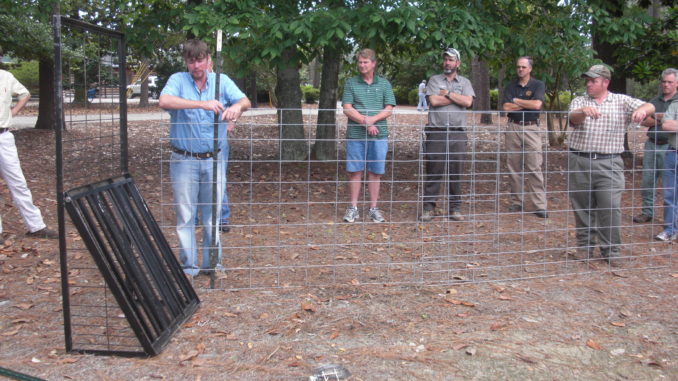
On May 12, the Dorchester County Clemson Extension Office organized a hog-management workshop, and the message was clear: get rid of wild hogs if you have the chance.
Speakers included biologist Charles Ruth of the S.C. Department of Natural Resources, extension agent Cory Heaton and USDA State Director Noel Myers; they addressed an audience of landowners and managers on how to address the wild-hog problem.
“This is what DNR wants, and we urge folks to trap them,” Ruth said. “Trapping is the best answer right now for managing both hogs and coyotes, as opposed to managing them via night hunting.
“Hogs are relatively limited in their distribution, along watersheds, as opposed to deer and turkeys, which are evenly distributed,” said Ruth.
The top counties to find hogs according to 2009 SCDNR data were Calhoun, Richland, Marion and Allendale. The only county to report no hogs in 2009 was Lexington, which is a Sandhills region that maintains a dry disposition and therefore is not that hospitable to hogs.
When it comes to trapping a wild hog, private landowners can use a trap to capture and kill hogs at will.
Ruth highlighted a new law that states it is unlawful to possess, buy, sell, offer for sale, transfer, release or transport wild hogs for the for the purpose of release. Special permits are required for moving captured wild hogs to permitted hog-hunting fence enclosures.
“The wild hog dilemma is having an impact on the environment and could affect things like endangered species in the long run,” said Myers, who related that the USDA’s Animal and Plant Inspection Service is testing what types of bait might be lethal to hogs but safe for the environment. Again, according to Myers, trapping seems to be the top choice for hog management.
“There is no rhyme or reason about how to trap hogs,” said Heaton. “Everybody can find a method that works for them. The problem of wild hogs increasing in number is not getting any better, so it’s important for those of us trapping now to do the best job we can to get rid of them.”
Heaton has years of experience trapping hogs and notes that poor trapping techniques can serve to educate the hops to become trap-shy.
“Scent control is becoming more and more important since the hog’s number one defense is their sense of smell,” said Heaton. “Distance monitoring is part of the equation to scent control, meaning don’t go into a trapping area on foot when you can use binoculars to check it.”
Photo surveillance using trail cams can also be crucial, because Heaton says not to set the trap door on the hog cage until the entire group is documented as using the trap. Again, if the trap catches just a few of the herd, the other hogs will become educated about going in a similar trap in the future.
Pre-bait the trap with things that hogs like to eat. The all-time No. 1 hog bait might be fish heads, but sour grains, sweet feed, grape jello, molasses, peaches and seasonal fruits like crabapples have all been proven to work well.
“The door to the trap is the most important element and I like to use a variety of doors,” said Heaton. “I’ll use drop doors (or guillotine doors), rooter doors, slammer doors or saloon doors.”
For a video of Heaton explaining some tips for setting up a hog trap using a rooter door click here.
Most corral traps are constructed with a 5×20-foot sheep/goat panels with 4×4-foot square mesh and steel T-posts. This type of panel will not allow smaller pigs to fit through the mesh or larger hogs to climb out of the trap. Most pig traps do not have a roof to allow for deer caught accidentally to escape.
Trapping is a learning process and materials can be expensive, so Heaton advises to keep several wire corrals set up but just to use one or two doors. The doors are the most expensive part of the trap and Heaton likes to rotate them around to any traps that are being used by hogs and ready for him to set and monitor.



Be the first to comment